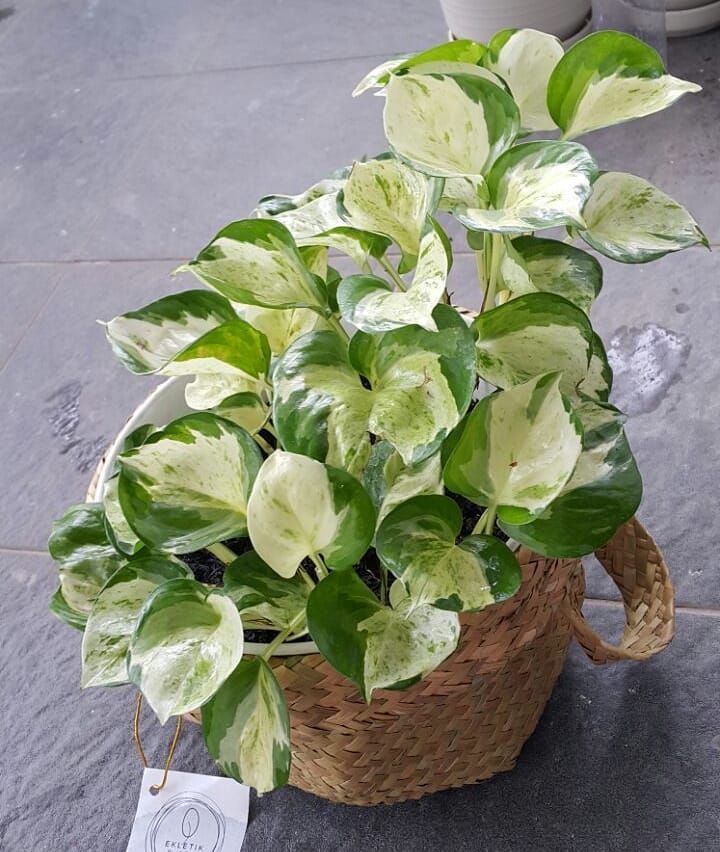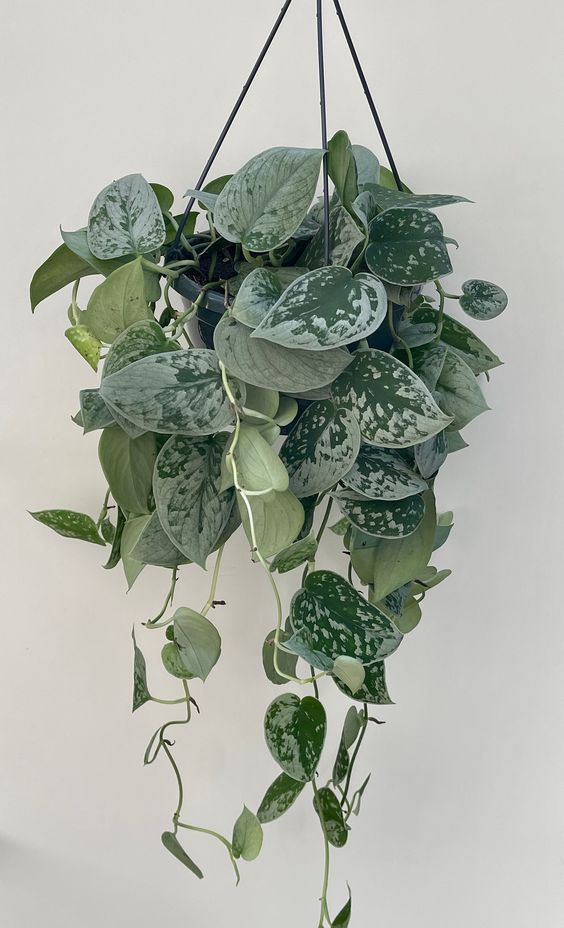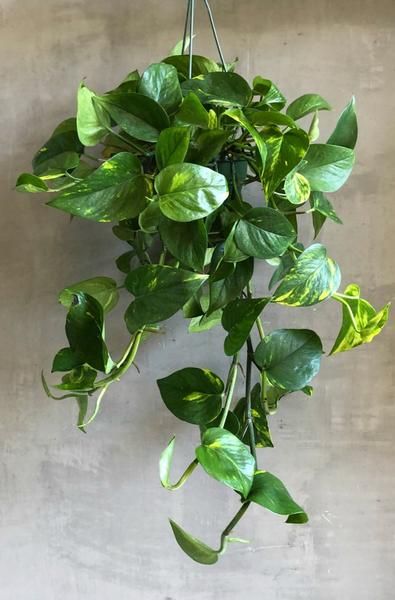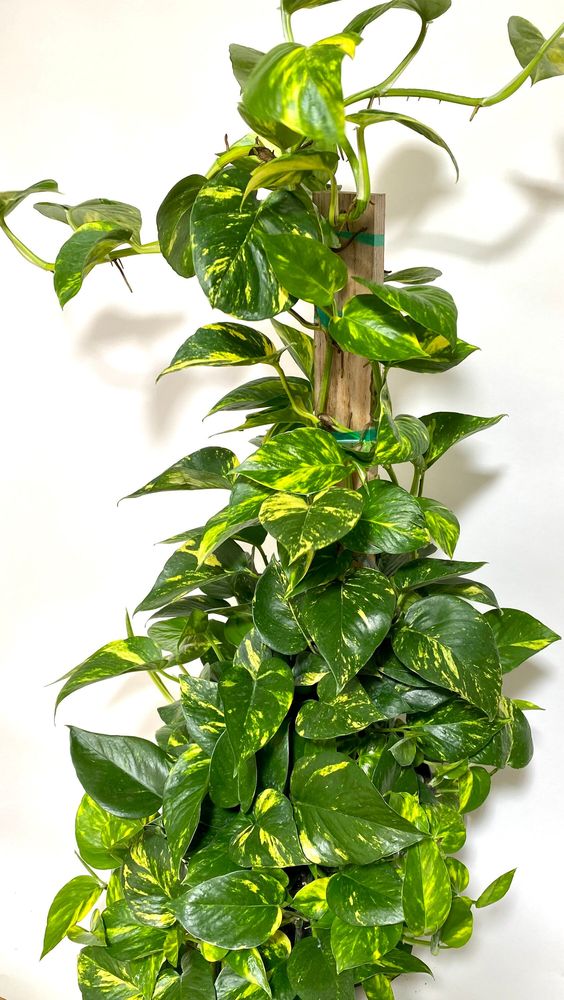

The heart-shaped leaves of Devil’s Ivy, also called Pothos (Epipremnum aureum), make it one of the most popular indoor plants globally because of its hardiness, adaptability, and attractive foliage. Whether you have a green thumb or just starting your indoor plant collection, pothos is a great choice. This article aims to give an in-depth look at pothos including its history, types, care tips, propagation methods, and frequently asked questions.
1. Origins and Overview
Pothos is a tropical vine native to the Solomon Islands in the South Pacific. In its indigenous environment, it can achieve lengths up to 40 feet with leaves reaching 3 feet long. However, when grown indoors as a houseplant it usually remains much smaller in stature with vines growing between six and ten feet long. Pothos belongs to the Araceae family which includes other well-known houseplants like philodendrons and anthuriums.
One reason why people love pothos so much is because you almost cannot kill them. It tolerates neglect incredibly well; it will thrive even in low-lighting conditions and can go without water for weeks on end. Therefore, if you are a beginner or want to bring some green into your home with minimal effort, this is the perfect plant.
2. Varieties of Pothos


Different types of pothos come in different colors and patterns. The commonly known varieties include the following:
a. Golden Pothos
Golden Pothos is the most common variety. Its green heart-shaped leaves have yellow-gold variegation that ranges from faint stripes to bold speckles. It also goes by the name Devil’s Ivy because it can still hold its bright color even when kept under low light conditions.
b. Marble Queen Pothos
Marble Queen pothos is another favorite type, distinguished by its white and green marbled leaves. In Marble Queen, however, variegation is more prominent with huge patches of creamy white mixed with some green color. This particular variety tends to grow at a slower rate than Golden Pothos, due to reduced chlorophyll in the leaves.
c. Neon Pothos
Neon pothos have bright lime-green leaves that almost seem to glow. There are usually no variations in colors on such foliage making them a standout feature in any indoor garden. Neon Pothos adds a vibrant pop of color to any room and is just as easy to care for as other varieties.
d. Jessenia Pothos
Jessenia pothos resembles Marble Queen but with less conspicuous variegation. Its leaves are blended with green and chartreuse which makes it appear softer and muted in comparison. Jessenia grows more slowly than other types like Marble Queen too.
e. Manjula Pothos
Wavy-edged leaves are characteristic of Manjula pothos, which come with green, white, and cream variegation. This type was bred by the University of Florida and is under patent protection so propagation without authorization is illegal. Manjula Pothos has an even more striking look with its uneven and distinctive leaf patterns.
f. Pearls and Jade Pothos
Pearls and Jade pothos are a smaller variety with green leaves that have white or grey variegation. The edges of the leaves are often variegated, which makes them appear more dainty. It’s a compact plant that’s perfect for small spaces.
3. Caring for Pothos


One of the major reasons why many people adore pothos is because it does not require much care. Below you will find some basic ideas on how to look after your pothos such that they remain healthy all through.
a. Light Requirements
When it comes to light, pothos can easily adapt to any condition. It can do well in dimly lit rooms because it thrives in low-light conditions. However, for optimum growth and bright variegation, place your Pothos in bright indirect light. High amounts of direct sunlight will burn the leaves causing them to turn brown and brittle.
Lack of enough light slows down the growth rate while causing fading color on leaf variegations in Pothos plants. To prevent this from happening, place your plant near a window situated on the north or east side where plenty of indirect sunlight reaches it since north-facing windows usually receive plenty of indirect sun over long periods daily throughout the year especially if they face another building or trees rather than open space like street view or garden view
b. Watering
Watering pothos is highly forgiving; that’s why it’s a favorite among busy gardeners. Better to under-water than overwater because overwatering can lead to root rot. Allow the soil to dry out for an inch before watering. In most cases, that means you’ll water your pothos every 1-2 weeks depending on the humidity and temperature in your house.
When watering, make sure to give the plant a good soak so that water runs through and drains out of holes at the bottom of the pot. Ensure the container has proper drainage in place to avoid water pooling at its bottom, which could cause root rot.
c. Soil
Pothos isn’t too picky about soil but thrives best in a well-draining potting mix. A standard indoor potting mix with some perlite or sand added will work fine. Soil should be loose and well-aerated to encourage free growth of roots.
If you find your soils do not drain well just repot your pothos into a mix containing more perlite or change pots with better drainage.
d. Temperature and Humidity
Pothos prefers temperatures ranging from 60-85°F (15-29°C) which are typical for most indoor environments. Keep it away from drafts, air conditioners, and heating vents as these sudden changes may stress it.
Pothos, however, prefers more humid environments than the low humidity it can put up with because it is a tropical plant. A room humidifier or a humidity tray placed beneath your pothos may help combat particularly dry air that frequently occurs in homes during the winter period.
e. Fertilizing
Pothos does not require heavy feeding, but an occasional application of fertilizer during the growing season (spring and summer) would be beneficial. Use a balanced, water-soluble fertilizer diluted to half strength every 4-6 weeks to encourage growth and healthy leaves.
By fall and winter when growth slows down, one can decrease or even cease fertilization altogether. Excessive applications of fertilizer result in salt build-up in soils, which could damage plants.
f. Pruning
To maintain the size of your pothos you should prune it regularly; this will also encourage bushier growth and prevent vines from becoming too leggy. When the tendrils become overgrown or straggly, cut just above a leaf node (the point on the stem where a leaf is attached). New growth will occur at the place where the cut is made.
Moreover, you can remove any yellow or damaged leaves to keep your pathos looking fresh and tidy. Regular pruning might also make it appear fuller and more compact especially when little light causes pathos to grow in length.”
4. Propagation


It’s a no-brainer to grow Pothos plants, thus this makes it suitable for individuals who want to expand their gardens or share them with friends. Most commonly, stem cutting is used.
a. Propagating in Water
- Choose the Healthy One: Make sure you settle for a healthy vine that has some leaves and at least four nodes.
- Cut Below a Node: With clean sharp scissors or pruning shears cut below the node on the stem about 4-6 inches long.
- Remove Lower Leaves: Remove any foliage from the lower half of the cutting, but leave a few leaves at the top.
- Soak in Water: Place the cutting in water ensuring that nodes are submerged and set the jar at a location with bright indirect light.
- Wait for roots to develop: The roots will start emerging after two to four weeks as you can see them growing out of node points. Once roots reach several inches, you can place them in soil media as cuttings.
b. Propagating in Soil
- Get Soil Ready: Fill a small pot with a well-draining potting mix.
- Plant Them In The Soil: Take your stem cutting as mentioned above and put it in soil burying also its node point(s).
- Water And Cover It Up: Water your cutting and then cover the pot with a plastic bag or dome making sure that there is enough humidity which enhances root development
- Put It Under Indirect Light: Place this on a bright spot but avoid direct sun; try pulling it gently after two weeks because
5. Common Problems and Solutions


While pothos is a resilient plant, it can have a few typical problems. The following are some of the issues you may encounter and how to solve them:
a. Yellowing Leaves
Yellowing leaves can indicate different things such as over-watering, under-watering, or insufficient light. Look at your watering regime and lighting to determine what is behind this. In case you watered the plant too much, let the soil dry out before watering again. Similarly, if it dried up too fast, enhance your watering schedule. You may also move the plant into more light.
b. Brown Leaf Tips
Brown leaf tips often indicate low humidity or erratic watering habits. Raise the humidity levels around your plant or make sure that it is regularly supplied with water without letting the soil become completely dry.
c. Leggy Growth
When plants grow ‘leggy’, this typically means they are not receiving enough light. Relocate your pothos to another position where there is indirect sun but in general brighter conditions are available. Also, cutting back leggy vines will stimulate new bushier growth.
d. Pests
Pothos are normally unattractive to pests; however, there are times when common houseplant enemies such as spider mites, mealybugs, and scale insects attack them. Regularly scan your plant for any signs of these bugs; besides use insecticidal soap or neem oil on any infestation found
6. FAQs About Pothos
Q: Is pothos safe for pets?
A: negative, pothos is poisonous to cats and dogs when eaten. If ingested, the plant has calcium oxalate crystals that can cause oral, tongue, or throat irritation and swelling. Therefore, keep your pets away from it or go for pet-friendly indoor plants in case you have pets at home.
Q: How often should I water my pothos?
A: You should water your pothos plant once the top inch of soil becomes dry. This usually means watering every 1-2 weeks, but it can vary depending on the humidity and temperature of your home.
Q: Can pothos grow in water permanently?
A: Yes, indeed! Is there anything wrong with keeping pothos growing indefinitely in water? However, remember to change out stale water regularly and supplement the occasional liquid feed as per requirements for the plant’s needs.
Q: Why are the leaves on my pothos turning yellow?
A: Over-watering, under-watering, or lack of light might result in yellow leaves. Please appraise this situation and adjust accordingly.
Q: Can I grow pothos outside?
A: Pothos can be grown outdoors in warm tropical areas where temperatures never drop below 50°F (10°C). In colder climates, it is advisable to maintain pothos as an indoor plant throughout the year or bring them inside during winter months.
Q: How do I make my pothos grow faster?
A: Putting pothos plants in bright indirect light plus fertilizing them frequently during their growing seasons will make them grow faster. Routine pruning also encourages denser growth leading to a fuller-looking specimen.
Q: What should I do if my pothos is leggy?
A: If your pothos is turning into a leggy plant, it’s probably due to a lack of light supply. Get a brighter spot for it and think about pruning those leggy vines to trigger new shoots.
Q: How can I make my pothos more variegated?
A: Bright indirect light helps to increase variegation in pothos plants. Variegation is more pronounced in plants receiving more light. However, avoid exposing the plant to direct sunlight as it may lead to leaf burning.
Q: Can I train my pothos to climb?
A: That’s right, pothos is a twining vine by nature. It would help if you erected something like trellis or moss poles or any other support for them. When they start to climb gently tie them up with the help of any support they are growing through.
Conclusion
Pothos is an adaptive green plant that thrives very well under various conditions, making it suitable for beginners and experienced gardeners. It quickly becomes a favorite choice of indoor gardening due to its broad varieties, low maintenance requirement, and easy propagation techniques. Whether you want just a little bit of greenery within your home or you are looking to expand on your collections; Pothos will never disappoint as it brings life and beauty into any space where it resides.







